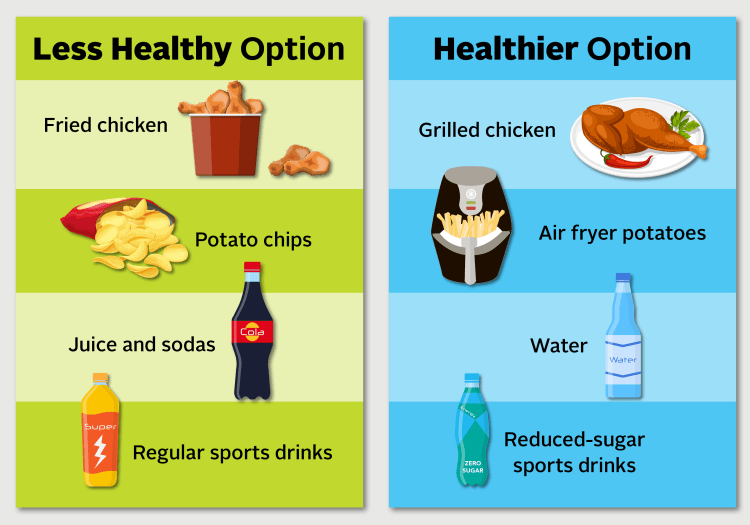Diabetes diet
Creating healthy eating plans for kids and adults.
Article Date:

According to the Centers for Disease Control and Prevention (CDC), more than 38 million Americans – about 1 in 9 people – have diabetes. Millions more are living with prediabetes, meaning their blood sugar levels are higher than normal but not yet in the diabetes range.
Diabetes is a chronic disease that affects how the body processes glucose (sugar), which is the main source of energy for cells. Without proper management, it can increase the risk of heart disease, kidney disease, nerve damage, vision loss and other serious health problems.
The two types of diabetes
Type 1
- An autoimmune condition in which the body’s immune system destroys insulin-producing cells in the pancreas. Insulin is a hormone that allows blood sugar to get into cells to be used for energy.
- Requires insulin through injections or an insulin pump.
- Usually diagnosed in children, teens or young adults but can occur at any age.
- Generally not caused by obesity or lifestyle factors.
Type 2
- The most common type, especially in adults, but increasingly seen in children.
- The body produces insulin but does not use it effectively (insulin resistance).
- Over time, the pancreas may not be able to produce enough insulin.
- Certain factors may increase risk, such as being overweight or inactive, family history and certain ethnic backgrounds.
Diabetes experts say healthy eating patterns and lifestyle changes play a central role in the management of the disease, regardless of which type a person has. The American Diabetes Association (ADA) emphasizes that there is no one “diabetic diet.” Instead, the goal is to build a sustainable, balanced way of eating. As always, talk with your doctor first before making any changes to your diet.
Caring for kids with diabetes
When coaching children with diabetes, clinical dietitians at the Northeast Florida Pediatric Diabetes Center at Wolfson Children’s Hospital and Nemours Children’s Health, Jacksonville, emphasize that change is a gradual process and the importance of gradual, family-wide changes rather than quick overhauls.
Type 1 diabetes in children
The team at the Pediatric Diabetes Center educates children and families with type 1 diabetes about the difference between carbohydrates, fats and proteins. Patients and families also learn how to count carbs and watch their sugar consumption so they can manage the amount of insulin needed from either a pump or injections. Technologies like insulin pumps and continuous glucose monitors help children manage diabetes and allow parents to monitor remotely.
“Roughly 40-50% of their diet should be carbohydrates,” said Mary Louise Fox, registered dietician and diabetes educator. “There is no number limit on carbs, but these patients need to check the serving size on nutrition labels and ensure they are portioning their food appropriately.”
Children with type 1 diabetes should look for opportunities to make the same healthy food swaps as kids with type 2 diabetes (see chart below), and they should try to avoid junk food and saturated fats.
Type 2 diabetes in children
The focus for children with type 2 diabetes is lifestyle changes, including exercise and weight loss, with an emphasis on choosing healthier options over high-fat foods and homemade meals instead of fast food. Here are some examples:

They also give patients with type 2 diabetes a plate to take home that has recommended serving sizes for each meal. The plate should be half filled with vegetables, one-quarter protein and one-quarter starch.
“It’s important that family members support the child and incorporate healthy food choices also. Kids and families should realize they're not alone,” Fox said. “We frequently reassess our patients to make sure we're finding strategies that work for them.”
Adjustments for adults
Casey Bonaquist, DO, a family physician and obesity medicine specialist with Baptist Primary Care and medical director of Baptist Metabolic Weight Loss, said much of the guidance is similar for adults with both types of diabetes.
“A good rule of thumb for people with type 1 diabetes, and anyone striving to live an overall healthy lifestyle, is to avoid processed foods and high-sugar foods,” Dr. Bonaquist said. “Added sugars can often be found in packaged and prepared foods.”
Dr. Bonaquist said eating sugary foods, even in moderation, is going to lead you to crave more sugar.
“It’s a cycle that’s hard to break and makes maintaining a healthy diet difficult. If you wean yourself off of added sugars, your body will eventually stop craving them, and you’ll feel more in control.”
Type 1 diabetes in adults
- Typically work closely with an endocrinologist and a dietitian to help manage their medications and diet.
- Newer technologies, such as continuous glucose monitors (CGMs) and hybrid closed-loop insulin pump systems, allow for more precise adjustments and flexibility with meals.
- The ADA stresses reducing processed foods and added sugars, which can make blood sugar harder to manage.
Type 2 diabetes in adults
- Lifestyle changes can significantly improve blood sugar, sometimes reducing the need for medications.
- Sudden diet changes may cause low blood sugar if combined with certain drugs (like insulin or sulfonylureas), so changes should always be reviewed with a physician.
- Keeping a food log or using a tracking app can help adults identify eating triggers, like boredom or stress, and make more mindful choices.
- Medications such as GLP-1 receptor agonists are now recommended not only for glucose control and weight management, but also for heart and kidney protection.
The bottom line
Diabetes is common, but with the right care, it can be managed successfully. For both children and adults, the ADA stresses the importance of whole foods, portion control, regular activity, and individualized care. Small, consistent changes add up to better control and a healthier life.
“If you gradually reduce added sugars and processed foods, your cravings fade, and you’ll feel more in control. It’s not about restriction; it’s about building habits that last,” said Dr. Bonaquist. “Before making major changes, always consult with your health care provider or a registered dietitian. With ongoing support, people living with diabetes can thrive.”
Do you have questions about diabetes?
If you’re concerned about your child having diabetes, talk to their pediatrician. To set up an appointment with the Pediatric Diabetes Center, call 904.202.8547 or visit wolfsonchildrens.com/diabetes.
If you’re concerned about diabetes and want to get screened, make an appointment with a Baptist Primary Care physician near you by calling 904.202.4YOU or scheduling an appointment online. Your primary care physician can help guide you through the next steps.


